CEFAZOLIN SODIUM
-
cefazolin sodium solution
B. Braun Medical Inc.
----------
To reduce the development of drug-resistant bacteria and maintain the effectiveness of Cefazolin for Injection USP and Dextrose Injection USP and other antibacterial drugs, Cefazolin for Injection USP and Dextrose Injection USP should be used only to treat or prevent infections that are proven or strongly suspected to be caused by bacteria.
DESCRIPTION
Cefazolin for Injection USP and Dextrose Injection USP is a sterile, nonpyrogenic, single use, packaged combination of Cefazolin Sodium USP (lyophilized) and sterile iso-osmotic diluent in the DUPLEX® sterile container. The DUPLEX® Container is a flexible dual chamber container.
After reconstitution the approximate osmolality for Cefazolin for Injection USP and Dextrose Injection USP is 290 mOsmol/kg.
The drug chamber is filled with sterile lyophilized Cefazolin Sodium USP, a semi-synthetic cephalosporin and has the following IUPAC nomenclature: Sodium (6R,7R)-3-[[(5-methyl-1,3,4-thiadiazol-2-yl)thio]methyl]-8-oxo-7-[2-(1H-tetrazol-1-yl)acetamido]-5-thia-1-azabicyclo[4.2.0]oct-2-ene-2-carboxylate.
Cefazolin Sodium USP has the following structural formula:

The sodium content is 48 mg/g of cefazolin sodium.
The diluent chamber contains Dextrose Injection USP, an iso-osmotic diluent using Hydrous Dextrose USP in Water for Injection USP. Dextrose Injection USP is sterile, nonpyrogenic, and contains no bacteriostatic or antimicrobial agents.
Hydrous Dextrose USP has the following structural (molecular) formula:

The molecular weight of Hydrous Dextrose USP is 198.17
Cefazolin Sodium USP is supplied as a lyophilized form equivalent to 1 g of cefazolin. Dextrose hydrous USP has been added to the diluent to adjust osmolality (approximately 2 g).
After removing the peelable foil strip, activating the seals, and thoroughly mixing, the reconstituted drug product is intended for single intravenous use.
The DUPLEX® Container is Latex-free, PVC-free, and Di (2-ethylhexyl) phthalate (DEHP)-free.
The DUPLEX® dual chamber container is made from a specially formulated material. The product (diluent and drug) contact layer is a mixture of thermoplastic rubber and a polypropylene ethylene copolymer that contains no plasticizers. The safety of the container system is supported by USP biological evaluation procedures.
CLINICAL PHARMACOLOGY
Studies have shown that following intravenous administration of cefazolin to normal volunteers, mean serum concentrations peaked at approximately 185 mcg/mL and were approximately 4 mcg/mL at 8 hours for a 1 gram dose.
The serum half-life for cefazolin is approximately 1.8 hours following IV administration.
In a study (using normal volunteers) of constant intravenous infusion with dosages of 3.5 mg/kg for 1 hour (approximately 250 mg) and 1.5 mg/kg the next 2 hours (approximately 100 mg), cefazolin produced a steady serum level at the third hour of approximately 28 mcg/mL.
Studies in patients hospitalized with infections indicate that cefazolin produces mean peak serum levels approximately equivalent to those seen in normal volunteers.
Bile levels in patients without obstructive biliary disease can reach or exceed serum levels by up to five times; however, in patients with obstructive biliary disease, bile levels of cefazolin are considerably lower than serum levels (<1.0 mcg/mL).
In synovial fluid, the cefazolin level becomes comparable to that reached in serum at about 4 hours after drug administration.
Studies of cord blood show prompt transfer of cefazolin across the placenta. Cefazolin is present in very low levels in the milk of nursing mothers.
Cefazolin is excreted unchanged in the urine. In the first 6 hours approximately 60% of the drug is excreted in the urine and this increases to 70% to 80% within 24 hours.
Controlled studies on adult normal volunteers, receiving 1 gram 4 times a day for 10 days, monitoring CBC, SGOT, SGPT, bilirubin, alkaline phosphatase, BUN, creatinine, and urinalysis, indicated no clinically significant changes attributed to cefazolin.
Microbiology
In vitro tests demonstrate that the bactericidal action of cephalosporins results from inhibition of cell wall synthesis. Cefazolin has been shown to be active against most strains of the following microorganisms, both in vitro and in clinical infections as described in INDICATIONS AND USAGE.
Gram-Positive Aerobes
Staphylococcus aureus (including beta-lactamase-producing strains)
Staphylococcus epidermidis
Strepotococcus pyogenes, Streptococcus agalactiae, and other strains of streptococci
Streptococcus pneumoniae
Methicillin-resistant staphylococci are uniformly resistant to cefazolin, and many strains of enterococci are resistant.
Susceptibility Tests
Diffusion Techniques
Quantitative methods that require measurement of zone diameters provide reproducible estimates of the susceptibility of bacteria to antimicrobial compounds. One such standardized procedure1 that has been recommended for use with disks to test the susceptibility of microorganisms to cefazolin uses the 30-mcg cefazolin disk. Results of the standardized single-disk susceptibility test1 with a 30-mcg cefazolin disk should be interpreted according to the following criteria:
| Zone Diameter (mm) | Interpretation |
|---|---|
| ≥18 | Susceptible (S) |
| 15–17 | Intermediate (I) |
| ≤14 | Resistant (R) |
Standardized single-disk susceptibility test should be performed ONLY with a 30-mcg cefazolin disk.
A report of "Susceptible" indicates that the pathogen is likely to be inhibited by usually achievable concentrations of the antimicrobial compound in the blood. A report of "Intermediate" indicates that the result should be considered equivocal, and, if the microorganism is not fully susceptible to alternative, clinically feasible drugs, the test should be repeated. This category implies possible clinical applicability in body sites where the drug is physiologically concentrated or in situations where high dosage of drug can be used. This category also provides a buffer zone that prevents small uncontrolled technical factors from causing major discrepancies in interpretation. A report of "Resistant" indicates that usually achievable concentrations of the antimicrobial compound in the blood are unlikely to be inhibitory and that other therapy should be selected.
Standardized susceptibility test procedures require the use of laboratory control microorganisms. The 30-mcg cefazolin disk should provide the following zone diameters in these laboratory test quality control strains:
| Microorganism | Zone Diameter (mm) |
|---|---|
| E. coli ATCC® 25922 | 21–27 |
| S. aureus ATCC® 25923 | 29–35 |
The cefazolin disk should not be used for testing susceptibility to other cephalosporins.
Dilution Techniques
Quantitative methods that are used to determine minimum inhibitory concentrations provide reproducible estimates of the susceptibility of bacteria to antimicrobial compounds. One such standardized procedure uses a standardized dilution method2 (broth, agar, or microdilution) or equivalent with cefazolin powder. The MIC values obtained should be interpreted according to the following criteria:
| MIC (mcg/mL) | Interpretation |
|---|---|
| ≤16 | Susceptible (S) |
| ≥64 | Resistant (R) |
Interpretation should be as stated above for results using diffusion techniques.
As with standard diffusion techniques, dilution methods require the use of laboratory control microorganisms. Standard cefazolin powder should provide the following MIC values:
| Microorganism | MIC (mcg/mL) |
|---|---|
| S. aureus ATCC® 25923 | 0.25–1.0 |
| E. coli ATCC® 25922 | 1.0–4.0 |
INDICATIONS AND USAGE
Cefazolin for Injection USP and Dextrose Injection USP is indicated in the treatment of the following infections due to susceptible organisms:
Respiratory Tract Infections: Due to S. pneumoniae, S. aureus (including beta-lactamase-producing strains) and S. pyogenes.
Injectable benzathine penicillin is considered to be the drug of choice in treatment and prevention of streptococcal infections, including the prophylaxis of rheumatic fever.
Cefazolin is effective in the eradication of streptococci from the nasopharynx; however, data establishing the efficacy of cefazolin in the subsequent prevention of rheumatic fever are not available.
Urinary Tract Infections: Due to E. coli, P. mirabilis.
Skin and Skin Structure Infections: Due to S. aureus (including beta-lactamase-producing strains), S. pyogenes, and other strains of streptococci.
Biliary Tract Infections: Due to E. coli, various strains of streptococci, P. mirabilis, and S. aureus.
Bone And Joint Infections: Due to S. aureus.
Genital Infections: (i.e., prostatitis, epididymitis) Due to E. coli, P. mirabilis.
Septicemia: Due to S. pneumoniae, S. aureus (including beta-lactamase-producing strains), P. mirabilis, E. coli.
Endocarditis: Due to S. aureus (including beta-lactamase-producing strains) and S. pyogenes.
Appropriate culture and susceptibility studies should be performed to determine susceptibility of the causative organism to cefazolin.
Perioperative Prophylaxis: The prophylactic administration of cefazolin preoperatively, intraoperatively, and postoperatively may reduce the incidence of certain postoperative infections in patients undergoing surgical procedures which are classified as contaminated or potentially contaminated (e.g., vaginal hysterectomy, and cholecystectomy in high-risk patients such as those older than 70 years, with acute cholecystitis, obstructive jaundice, or common duct bile stones).
The perioperative use of cefazolin may also be effective in surgical patients in whom infection at the operative site would present a serious risk (e.g., during open-heart surgery and prosthetic arthroplasty).
The prophylactic administration of cefazolin should usually be discontinued within a 24-hour period after the surgical procedure. In surgery where the occurrence of infection may be particularly devastating (e.g., open-heart surgery and prosthetic arthroplasty), the prophylactic administration of cefazolin may be continued for 3 to 5 days following the completion of surgery.
If there are signs of infection, specimens for cultures should be obtained for the identification of the causative organism so that appropriate therapy may be instituted.
(See DOSAGE AND ADMINISTRATION.)
To reduce the development of drug-resistant bacteria and maintain the effectiveness of Cefazolin for Injection USP and Dextrose Injection USP and other antibacterial drugs, Cefazolin for Injection USP and Dextrose Injection USP should be used only to treat or prevent infections that are proven or strongly suspected to be caused by susceptible bacteria. When culture and susceptibility information are available, they should be considered in selecting or modifying antibacterial therapy. In the absence of such data, local epidemiology and susceptibility patterns may contribute to the empiric selection of therapy.
CONTRAINDICATIONS
CEFAZOLIN FOR INJECTION USP AND DEXTROSE INJECTION USP IS CONTRAINDICATED IN PATIENTS WITH KNOWN ALLERGY TO THE CEPHALOSPORIN GROUP OF ANTIBIOTICS.
Solutions containing dextrose may be contraindicated in patients with hypersensitivity to corn products.
WARNINGS
BEFORE THERAPY WITH CEFAZOLIN FOR INJECTION USP AND DEXTROSE INJECTION USP IS INSTITUTED, CAREFUL INQUIRY SHOULD BE MADE TO DETERMINE WHETHER THE PATIENT HAS HAD PREVIOUS HYPERSENSITIVITY REACTIONS TO CEFAZOLIN, CEPHALOSPORINS, PENICILLINS, OR OTHER DRUGS. IF THIS PRODUCT IS GIVEN TO PENICILLIN-SENSITIVE PATIENTS, CAUTION SHOULD BE EXERCISED BECAUSE CROSS-HYPERSENSITIVITY AMONG BETA-LACTAM ANTIBIOTICS HAS BEEN CLEARLY DOCUMENTED AND MAY OCCUR IN UP TO 10% OF PATIENTS WITH A HISTORY OF PENICILLIN ALLERGY. IF AN ALLERGIC REACTION TO CEFAZOLIN FOR INJECTION USP AND DEXTROSE INJECTION USP OCCURS, DISCONTINUE TREATMENT WITH THE DRUG. SERIOUS ACUTE HYPERSENSITIVITY REACTIONS MAY REQUIRE TREATMENT WITH EPINEPHRINE AND OTHER EMERGENCY MEASURES, INCLUDING OXYGEN, IV FLUIDS, IV ANTIHISTAMINES, CORTICOSTEROIDS, PRESSOR AMINES AND AIRWAY MANAGEMENT, AS CLINICALLY INDICATED.
Clostridium difficile associated diarrhea (CDAD) has been reported with use of nearly all antibacterial agents, including Cefazolin for Injection USP and Dextrose Injection USP, and may range in severity from mild diarrhea to fatal colitis. Treatment with antibacterial agents alters the normal flora of the colon leading to overgrowth of C. difficile.
C. difficile produces toxins A and B which contribute to the development of CDAD. Hypertoxin producing strains of C. difficile cause increased morbidity and mortality, as these infections can be refractory to antimicrobial therapy and may require colectomy. CDAD must be considered in all patients who present with diarrhea following antibiotic use. Careful medical history is necessary since CDAD has been reported to occur over two months after the administration of antibacterial agents.
If CDAD is suspected or confirmed, ongoing antibiotic use not directed against C. difficile may need to be discontinued. Appropriate fluid and electrolyte management, protein supplementation, antibiotic treatment of C. difficile, and surgical evaluation should be instituted as clinically indicated.
PRECAUTIONS
General
Prolonged use of Cefazolin for Injection USP and Dextrose Injection USP may result in the overgrowth of nonsusceptible organisms. Careful clinical observation of the patient is essential.
When Cefazolin for Injection USP and Dextrose Injection USP is administered to patients with low urinary output because of impaired renal function, lower daily dosage is required (see DOSAGE AND ADMINISTRATION).
As with other beta-lactam antibiotics, seizures may occur if inappropriately high doses are administered to patients with impaired renal function (see DOSAGE AND ADMINISTRATION).
Cefazolin for Injection USP and Dextrose Injection USP, as with all cephalosporins, should be prescribed with caution in individuals with a history of gastrointestinal disease, particularly colitis.
Cephalosporins may be associated with a fall in prothrombin activity. Those at risk include patients with renal or hepatic impairment or poor nutritional state, as well as patients receiving a protracted course of antimicrobial therapy, and patients previously stabilized on anticoagulant therapy. Prothrombin time should be monitored in patients at risk and exogenous vitamin K administered as indicated.
As with other dextrose-containing solutions, Cefazolin for Injection USP and Dextrose Injection USP should be prescribed with caution in patients with overt or known subclinical diabetes mellitus or carbohydrate intolerance for any reason.
Prescribing Cefazolin for Injection USP and Dextrose Injection USP in the absence of a proven or strongly suspected bacterial infection or a prophylactic indication is unlikely to provide benefit to the patient and increases the risk of the development of drug-resistant bacteria.
If administration is controlled by a pumping device, care must be taken to discontinue pumping action before the container runs dry or air embolism may result.
Use only if solution is clear and container and seals are intact.
Drug Interactions
Probenecid may decrease renal tubular secretion of cephalosporins when used concurrently, resulting in increased and more prolonged cephalosporin blood levels.
Drug/Laboratory Test Interactions
A false positive reaction for glucose in the urine may occur with Benedict's solution, Fehling's solution or with Clinitest® tablets, but not with enzyme-based tests such as Clinistix®.
Positive direct and indirect antiglobulin (Coombs) tests have occurred; these may also occur in neonates whose mothers received cephalosporins before delivery.
Information for Patients
Diarrhea is a common problem caused by antibiotics which usually ends when the antibiotic is discontinued. Sometimes after starting treatment with antibiotics, patients can develop watery and bloody stools (with or without stomach cramps and fever) even as late as two or more months after having taken the last dose of the antibiotic. If this occurs, patients should contact their physician as soon as possible.
Patients should be counseled that antibacterial drugs including Cefazolin for Injection USP and Dextrose Injection USP should only be used to treat bacterial infections. They do not treat viral infections (e.g., the common cold). When Cefazolin for Injection USP and Dextrose Injection USP is prescribed to treat a bacterial infection, patients should be told that although it is common to feel better early in the course of therapy, the medication should be taken exactly as directed. Skipping doses or not completing the full course of therapy may (1) decrease the effectiveness of the immediate treatment, and (2) increase the likelihood that bacteria will develop resistance and will not be treatable by Cefazolin for Injection USP and Dextrose Injection USP or other antibacterial drugs in the future.
Carcinogenesis/Mutagenesis
Mutagenicity studies and long-term studies in animals to determine the carcinogenic potential of Cefazolin for Injection USP and Dextrose Injection USP have not been performed.
Pregnancy
Teratogenic Effects
Pregnancy Category B
Reproduction studies have been performed in rats, mice, and rabbits at doses up to 25 times the human dose and have revealed no evidence of impaired fertility or harm to the fetus due to cefazolin. There are, however, no adequate and well-controlled studies in pregnant women. Because animal reproduction studies are not always predictive of human response, this drug should be used during pregnancy only if clearly needed.
Labor and Delivery
When cefazolin has been administered prior to caesarean section, drug levels in cord blood have been approximately one quarter to one third of maternal drug levels. The drug appears to have no adverse effect on the fetus.
Nursing Mothers
Cefazolin is present in very low concentrations in the milk of nursing mothers. Caution should be exercised when Cefazolin for Injection USP and Dextrose Injection USP is administered to a nursing woman.
Pediatric Use
Cefazolin for Injection USP and Dextrose Injection USP is designed to deliver a 1 g dose of cefazolin. To prevent unintentional overdose, Cefazolin for Injection USP and Dextrose Injection USP should not be used in pediatric patients who require less than the full adult dose of cefazolin.
Geriatric Use
Of the 920 subjects who received cefazolin in clinical studies, 313 (34%) were 65 years and over, while 138 (15%) were 75 years and over. No overall differences in safety or effectiveness were observed between these subjects and younger subjects. Other reported clinical experience has not identified differences in responses between the elderly and younger patients, but greater sensitivity of some older individuals cannot be ruled out.
This drug is known to be substantially excreted by the kidney, and the risk of toxic reactions to this drug may be greater in patients with impaired renal function. Because elderly patients are more likely to have decreased renal function, care should be taken in dose selection, and it may be useful to monitor renal function (see PRECAUTIONS, General and DOSAGE AND ADMINISTRATION).
ADVERSE REACTIONS
The following reactions have been reported:
Gastrointestinal: Diarrhea, oral candidiasis (oral thrush), vomiting, nausea, stomach cramps, anorexia and pseudomembranous colitis. Onset of pseudomembranous colitis symptoms may occur during or after antibiotic treatment (see WARNINGS). Nausea and vomiting have been reported rarely.
Allergic: Anaphylaxis, eosinophilia, itching, drug fever, skin rash, Stevens-Johnson syndrome.
Hematologic: Neutropenia, leukopenia, thrombocytopenia, thrombocythemia.
Hepatic: Transient rise in SGOT, SGPT, and alkaline phosphatase levels has been observed. As with other cephalosporins, reports of hepatitis have been received.
Renal: As with other cephalosporins, reports of increased BUN and creatinine levels, as well as renal failure, have been received.
Local Reactions: Rare instances of phlebitis have been reported at site of injection. Some induration has occurred.
Other Reactions: Genital and anal pruritus (including vulvar pruritus, genital moniliasis, and vaginitis).
DOSAGE AND ADMINISTRATION
Usual Adult Dosage
| Type of Infection | Dose | Frequency |
|---|---|---|
|
||
| Moderate to severe infections | 500 mg to 1 gram | every 6 to 8 hours |
| Mild infections caused by susceptible gram-positive cocci | 250 mg to 500 mg | every 8 hours |
| Acute, uncomplicated urinary tract infections | 1 gram | every 12 hours |
| Pneumococcal pneumonia | 500 mg | every 12 hours |
| Severe, life-threatening infections (e.g., endocarditis, septicemia)* | 1 gram to 1.5 grams | every 6 hours |
Perioperative Prophylactic Use
To prevent postoperative infection in contaminated or potentially contaminated surgery, recommended doses are:
- 1 gram IV administered 1/2 hour to 1 hour prior to the start of surgery.
- For lengthy operative procedures (e.g., 2 hours or more), 500 mg to 1 gram IV during surgery (administration modified depending on the duration of the operative procedure).
- 500 mg to 1 gram IV every 6 to 8 hours for 24 hours postoperatively.
It is important that (1) the preoperative dose be given just (1/2 to 1 hour) prior to the start of surgery so that adequate antibiotic levels are present in the serum and tissues at the time of initial surgical incision; and (2) cefazolin be administered, if necessary, at appropriate intervals during surgery to provide sufficient levels of the antibiotic at the anticipated moments of greatest exposure to infective organisms.
In surgery where the occurrence of infection may be particularly devastating (e.g., open-heart surgery and prosthetic arthroplasty), the prophylactic administration of cefazolin may be continued for 3 to 5 days following the completion of surgery.
Dosage Adjustment for Patients with Reduced Renal Function
Cefazolin may be used in patients with reduced renal function with the following dosage adjustments: Patients with a creatinine clearance of 55 mL/min. or greater or a serum creatinine of 1.5 mg % or less can be given full doses. Patients with creatinine clearance rates of 35 to 54 mL/min. or serum creatinine of 1.6 to 3.0 mg % can also be given full doses but dosage should be restricted to at least 8 hour intervals. Patients with creatinine clearance rates of 11 to 34 mL/min. or serum creatinine of 3.1 to 4.5 mg % should be given 1/2 the usual dose every 12 hours. Patients with creatinine clearance rates of 10 mL/min. or less or serum creatinine of 4.6 mg % or greater should be given 1/2 the usual dose every 18 to 24 hours. All reduced dosage recommendations apply after an initial loading dose appropriate to the severity of the infection.
DUPLEX® Drug Delivery System Directions for Use
- To avoid inadvertent activation, DUPLEX® Container should remain in the folded position until activation is intended.
Patient Labeling and Drug Powder/Diluent Inspection
- Apply patient-specific label on foil side of container. USE CARE to avoid activation. Do not cover any portion of foil strip with patient label.
- Unlatch side tab and unfold DUPLEX® Container. (See Diagram 1.)
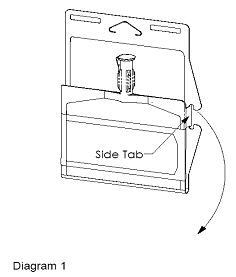
- Visually inspect diluent chamber for particulate matter.
- Use only if container and seals are intact.
- To inspect the drug powder for foreign matter or discoloration, peel foil strip from drug chamber. (See Diagram 2.)
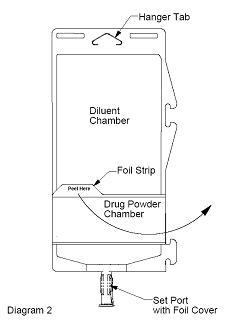
- Protect from light after removal of foil strip.
Note: If foil strip is removed, product must be used within 7 days, but not beyond the labeled expiration date. - The product should be re-folded and the side tab latched until ready to activate.
Reconstitution (Activation)
- Do not use directly after storage by refrigeration, allow the product to equilibrate to room temperature before patient use.
- Unfold the DUPLEX® Container and point the set port in a downward direction. Starting at the hanger tab end, fold the DUPLEX® Container just below the diluent meniscus trapping all air above the fold. To activate, squeeze the folded diluent chamber until the seal between the diluent and powder opens, releasing diluent into the drug powder chamber. (See Diagram 3.)
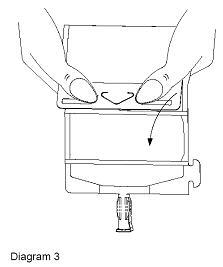
- Agitate the liquid-powder mixture until the drug powder is completely dissolved.
Note: Following reconstitution (activation), product must be used within 24 hours if stored at room temperature or within 7 days if stored under refrigeration.
Administration
- Visually inspect the reconstituted solution for particulate matter.
- Point the set port in a downwards direction. Starting at the hanger tab end, fold the DUPLEX® Container just below the solution meniscus trapping all air above the fold. Squeeze the folded DUPLEX® Container until the seal between reconstituted drug solution and set port opens, releasing liquid to set port. (See Diagram 4.)
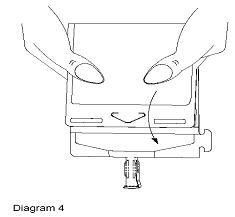
- Prior to attaching the IV set, check for minute leaks by squeezing container firmly. If leaks are found, discard container and solution as sterility may be impaired.
- Using aseptic technique, peel foil cover from the set port and attach sterile administration set. (See Diagram 5.)
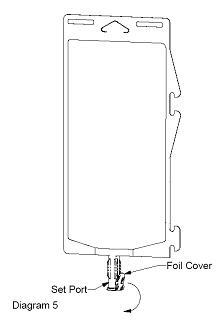
- Refer to Directions for Use accompanying the administration set.
Precautions
- As with other cephalosporins, reconstituted Cefazolin for Injection USP and Dextrose Injection USP tends to darken depending on storage conditions, within the stated recommendations. However, product potency is not adversely affected.
- Use only if prepared solution is clear and free from particulate matter.
- Do not use in series connection.
- Do not introduce additives into the DUPLEX® Container.
- Do not freeze.
HOW SUPPLIED
Cefazolin for Injection USP and Dextrose Injection USP in the DUPLEX® Drug Delivery System is a flexible dual chamber container supplied in one concentration. After reconstitution, the concentration is equivalent to 1 g cefazolin. The diluent chamber contains approximately 50 mL of Dextrose Injection USP. Dextrose Injection USP has been adjusted to 4.0% for the 1 g dose, such that the reconstituted solution is iso-osmotic.
Cefazolin for Injection USP and Dextrose Injection USP is supplied sterile and nonpyrogenic in the DUPLEX® Drug Delivery System containers packaged 24 units per case.
| NDC | Cat. No. | Dose | Volume |
|---|---|---|---|
| Cefazolin for Injection USP and Dextrose Injection USP | |||
| 0264-3103-11 | 3103-11 | 1 g | 50 mL |
REFERENCES
- National Committee for Clinical Laboratory Standards (NCCLS). January 2003. Performance Standards for Antimicrobial Disk Susceptibility Tests; Approved Standard-Eighth Edition. NCCLS Document M2-A8 and Disk Diffusion Supplemental Tables M100-S13. NCCLS, Wayne, PA, USA.
- National Committee for Clinical Laboratory Standards (NCCLS). January 2003. Methods for Dilution Antimicrobial Susceptibility Tests for Bacteria that Grow Aerobically; Approved Standard-Sixth Edition. NCCLS Document M7-A6 and MIC Testing Supplemental Tables, M100-S13. NCCLS, Wayne, PA, USA.
DUPLEX is a registered trademark of B. Braun Medical Inc.
ATCC is a registered trademark of American Type Culture Collection.
Clinitest is a registered trademark of Siemens Medical Solutions Diagnostics.
Clinistix is a registered trademark of Bayer Healthcare LLC.
U.S. Patent Nos. D388,168, D397,789, D402,366, D407,816, 5,176,634, 5,944,709, 6,165,161, 6,203,535, 6,846,305, and 6,996,951.
Made in USA
B. Braun Medical Inc.
Irvine, CA USA 92614-5895
©2008 B. Braun Medical Inc.
Y36-002-656
PRINCIPAL DISPLAY PANEL - 50 mL Container Label
Cefazolin for Injection USP
and Dextrose Injection USP
1 g*
REF 3103-11
NDC 0264-3103-11
DUPLEX®
DRUG DELIVERY SYSTEM
50 mL
Use only after mixing contents of both chambers.
For IV Use Only
Iso-osmotic
Single Dose
Sterile/Nonpyrogenic
* Contains Cefazolin Sodium USP equivalent to 1 g cefazolin.
Reconstitution: Hold container with set port in a downward direction and fold
the diluent chamber just below the solution meniscus. To activate seal, squeeze
folded diluent chamber until seal between diluent and drug chamber opens,
releasing diluent into drug chamber. Agitate the reconstituted solution until the
drug powder is completely dissolved. Fold the container a second time and
squeeze until seal between drug chamber and set port opens.
After reconstitution each 50 mL single dose unit contains: Cefazolin for Injection
USP (equivalent to 1 g cefazolin) with approx. 2.0 g (4.0% w/v) Hydrous Dextrose
USP in Water for Injection USP. Sodium content is 48 mg/g of cefazolin sodium.
Approximate osmolality: 290 mOsmol/kg
Prior to Reconstitution: Store at 20-25°C (68-77°F). Excursions permitted to
15-30°C (59-86°F). [See USP Controlled Room Temperature.] Use only if container
and seals are intact. Do not peel foil strip until ready for use. After foil strip
removal, product must be used within 7 days, but not beyond the labeled
expiration date. Protect from light after removal of foil strip.
After Reconstitution: Use only if prepared solution is clear and free from
particulate matter. Use within 24 hours if stored at room temperature or within
7 days if stored under refrigeration. Do not use in a series connection. Do not
introduce additives into this container. Prior to administration check for minute
leaks by squeezing container firmly. If leaks are found, discard container and
solution as sterility may be impaired. Do not freeze.
Rx only
The DUPLEX Container is Latex-free, PVC-free, and DEHP-free.
B. Braun Medical Inc.
Y37-002-399
LD-201-2
EXP LOT
Made in USA
PEEL HERE
Drug Chamber
Discard unit if foil strip is damaged. Peel foil strip only when ready for use. Visually inspect drug prior to reconstitution.
See package insert for complete directions for reconstitution and administration.
LD-336-1 X27-001-485


| CEFAZOLIN SODIUM
cefazolin sodium solution |
||||||||||||||||||
|
||||||||||||||||||
|
||||||||||||||||||
|
||||||||||||||||||
|
||||||||||||||||||
|
||||||||||||||||||
| Marketing Information | |||
| Marketing Category | Application Number or Monograph Citation | Marketing Start Date | Marketing End Date |
| NDA | NDA050779 | 07/27/2000 | |
| Labeler - B. Braun Medical Inc. (002397347) |
Revised: 10/2011 B. Braun Medical Inc.